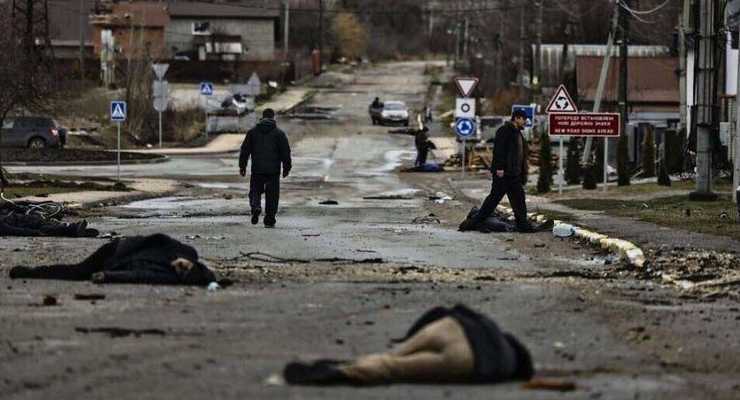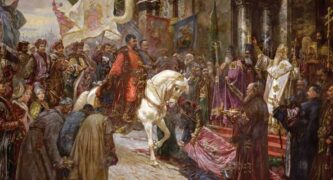
On April 3rd, the whole world saw the real face of Russian soldiers. The small cities of Bucha, Irpin, and Hostomel, close to Ukraine’s capital, will now become a symbol of mass massacres committed by Russians. Hundreds of Ukrainian civilians were tortured and murdered by Russians, proving that Putin’s neofascist regime is an existential enemy of Ukraine and the Western world.
This totally mad and needless war, which Russia started on a large scale on Feb 24th, has a long story behind it. This post will provide the historical context of what is now happening in Ukraine – a country fighting for its survival for 39 days.
Back in 2014, Russia invaded Ukraine and seized its territories. More than 13,000 Ukrainians were killed over 2 years, and at least 10% of Ukrainian territory was captured. After signing the Minsk II peace deal in February 2015, we could never imagine that Russians would dare bomb Ukrainian schools and theatres, destroying civilian infrastructure. There is no justification for what Russia is doing in Ukraine, and no “history behind it” can explain this crime against humanity.
But there is a story behind the current war, and its roots are long-standing.
In the 17th century, Ukrainian ruler Bohdan Khmelnytsky made a deal with the Moscow tsar. They signed the Pereyaslav Agreement in 1654, which mainly concerned the security and protection that Moscow could provide to Ukraine against Poland. The “protectorate” led to further destruction of the Ukrainian state and was never followed by Moscow tsar and his allies.

After a series of wars and a period that Ukrainian historians call “ruin”, the country was divided between Poland and Moscow. The deep political crisis within the Polish state led to Poland’s fall, and by the end of 18th century, 80% of modern Ukraine was controlled by the Russian umpire. The remaining 20% of the territory was seized by an Austrian emperor. The final crash of Polish rule in Ukraine happened in 1795.
Later on, Moscow had absolute power in Ukraine and did everything to demolish Ukrainian culture and unify it with that of Russia. The myth about the “second sort” of culture, language and traditions was created and actively supported at all levels of governance. Meanwhile, Russian tsars always felt the danger. Modern historians have discovered more than 140 orders, circulars, and laws issued where the Ukrainian language was restricted or completely prohibited in science, literature, and the media.
This lasted until 1917, when the era of Russian empire ended in the fall of the tsar and the rise of the national movements in the Baltic, Caucasia region, and Ukraine. The Bolsheviks, who took power in Moscow due to the October Revolution, declared their will to “gather back” the empire’s land. The change of political regime in the Kremlin did not change Moscow’s imperialistic ambitions.
So, when Ukrainian Central Rada (parliament) announced the Act of Independence of Ukraine in January 1918, the modern story of the Ukraine–Russian war began. Unfortunately, the idea of independence and of national statehood didn’t gain enough support among the Ukrainian people. The Bolsheviks’ super-simple slogans did the dirty deed. Ukrainians didn’t resist at full scale when Russian forces bombed Kyiv in 1918. It was a tough winter for the citizen of Ukraine’s capital. According to historians, more than 5.000 civilians were murdered just in a month. Bolshevik commander-general Mykhailo Muravyov wrote after: “I captured the city. We bombarded palaces and churches. No one could escape. Hundreds of generals, maybe even thousands, were killed with no remorse! It was our revenge. We could stop the anger of revenge, but we did not do this bacause it was our motto – no mercy!”
Surely, when Muravyov told about “generals” he was lying. The “red terror” was applied to Kyiv citizens who were tortured, murdered, killed, and left lying dead on the capital’s streets.
In 1921, the Ukrainian People’s Republic ended its own story. After the dashed hopes of independence, we had 70 years of “Soviet Ukraine”, with at least 5 million Ukrainian farmers and their families murdered during the Holodomor period: artificial starvation created by the Bolsheviks in 1932–33. After this time, millions of Ukrainians were deported to Siberia, and millions were killed during the following years of political cleansing.
Ukrainian people have paid a high price for their passiveness in the 1918–21 national-liberty war.
As their successors, we still pay a high price for the right to be free from Moscow’s rule.
In 1991, the Soviet Union crashed. Ukrainians voted for independence and supported the idea of sovereignty. According to Putin and Moscow elites, former communists and KDB servicemen, the fall of USSR was the “largest geopolitical catastrophe” of the 20th century. The words of Putin and his allies should be considered a public warning to all former Soviet republics. But this rhetoric from Putin and his representative regime was never taken seriously in Ukraine. Instead, we all saw it as a play of words for internal consumers, the Russian electorate. This was our core mistake. Now, we are truly paying for this miscalculation.
Putin and his allies create the ideology which allows the country’s rulers, soldiers, and media reps to justify mass killings and aggression against its neighbors. We have already seen this sort of ideology in Nazi Germany.
Russian propaganda has created a historical myth about Ukraine as a “non-existent” country formed by Lenin and his allies. Russian propaganda has also facilitated mass killings in Ukraine through information campaigns aimed at dehumanizing Ukrainians. This and other myths about NATO aggression, Ukrainian Nazis, and historical revenge have created provided a strong impetus for low-educated and fobbed-off Russian soldiers to commit their current crimes against humanity in Ukraine.
Stripping Ukrainians of their right to live and make choices about their future, Russia continues its long-standing policy and remains the enemy of Ukraine’s being. This war marks the next chapter in Ukraine’s tragedy and in its history of the fight for physical and geographical presence.
After the mass massacres in Bucha, Irpen, Hostomel, Mariupol, and many more Ukrainian cities, Russia’s new “post-Soviet” story has ended. The state ruled by Putin and his KGB friends will fall and never rise again. This is a matter of Ukraine’s survival. This is a matter of the Western world’s existence.
Jack Jones says
Thanks for filling in so many holes, with your well informed panorama of history. The same sentiments that lingered in 1939 are rampant now,”it can’t happen in our modern day such acts of violence “. You brought the reality that certain men are ruthless and violent and today they are doing evil and lying their way to bring it about! I hope to hear more from you soon!